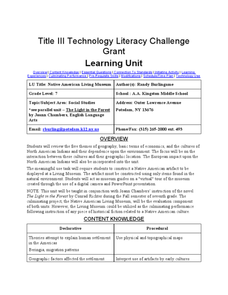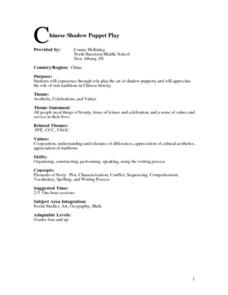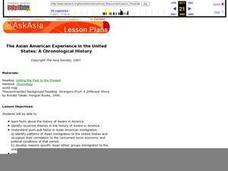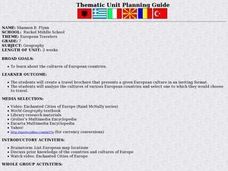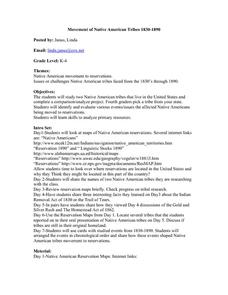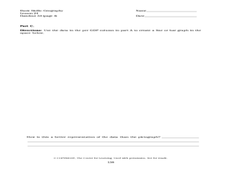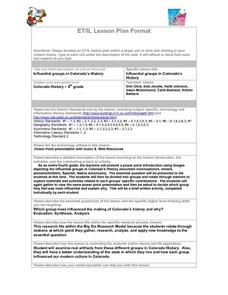Curated OER
Native American Living Museum
Seventh graders complete a unit of lessons on Native Americans. They analyze Native American cultures, create a Native American artifact for a Living Museum, and develop a tour of the museum using a digital camera and a Powerpoint...
Curated OER
Chinese Shadow Puppet Play
Students experience through role-play the art of shadow puppetry and appreciate the role of oral traditions in Chinese history. They research the origins and history of puppetry as a part of a unit on China. They discover what Chinese...
Curated OER
The Cold War and Development of Post-War America
Young scholars view examples of political advertisements during the years of 1952 through 1964. After viewing, they discuss how the Cold War and the threat of Communism affected the development of the United States. They compare the Cold...
Curated OER
Solid Waste and Our Natural Resources: Utilizing the Story THE LORAX
Students gain an introduction to our planet's solid waste problem and our personal responsibility in curbing and solving said problem through the use of Dr. Seuss' book, The Lorax. After hearing the book, class discussion follows.
Curated OER
Valley Forge
Learners describe how location, weather, and physical environment affect the way people live, including the effects on their food, clothing, shelter, transportation, and recreation. They also describe the lives of American heroes who...
Curated OER
If the World Was a Village...Examining Ethnocentrism
Seventh graders examine their own perceptions of world's people, compare those perceptions to real demographic data, provide definition and understanding of term "ethnocentrism," and examine their own ethnocentrism based on comparison of...
Curated OER
President Jackson, the Cherokee and Indian Removal
Students interpret historical evidence presented in primary and secondary resources. In this Indian Removal Act lesson, students examine the act and discuss the implications of moving the Cherokee. Students...
Curated OER
The Asian American Experience in the United States: A Chronological History
Eleventh graders understand push-pull factor in Asian Amencan immigration. They identify patterns of Asian immigration to the United States and recognize their correlation to the concurrent socio-economic and political conditions of that...
Curated OER
European Travelers
Seventh graders explore the European travelers and culture. They create a travel brochure that presents a given European culture in an inviting format. Students analyze the cultures of various European countries and select one they would...
Curated OER
Movement of Native American Tribes 1830-1890
Students examine the movement of Native American tribes during the mid 1800's. In this American History lesson, students study two Native American tribes that live in the United States and complete a comparison/analyze project. Students...
Curated OER
The First Americans
Students participate in theatre activities to study American history. In this American history and theatre lesson, students work in groups to research a specific Native American group to investigate their lifestyle. Students then create...
Curated OER
Population and Population Density
Students read and interpret graphs. In this population lesson, students explore population and population density as they read several data graphs and respond to questions.
Curated OER
The Geographic Doctor Seuss
Students define the term region using semantic mapping, listen to the Dr. Seuss story Yertle the Turtle, and discuss the conflict over borders in the story. They draw a map divided into regions.
Curated OER
Study of New York City
Fourth graders read A Cricket in Times Square and examine the essence of living in New York City. They examine subway maps and other resources concerning NYC and then complete several writing activities about the city. They also create...
Curated OER
The Life and Death of the Byzantine Empire
Ninth graders understand the state of the world around the year 1000 AD as it pertains to the Byzantine Empire. They analyze and discuss the characteristics of the Byzantine Empire.
Curated OER
Harvest
Students research the harvest period in Afghanistan. In this harvest lesson plan, students learn about Afghanistan's weather, games children play, rug designing, harvest songs, and more about the harvest time.
Curated OER
Archaeological Study
Students analyze the difference between archaeology and anthropology while studying the evolution of different products. In this archaeology and anthropology lesson, students trace the progression of a certain tool or product and come up...
Curated OER
Influential Groups In Colorado's History
Fourth graders watch a teacher made PowerPoint presentation that introduces the study of Colorado's history. They view images and listen to music that is indicative of the mountain men, miners, pioneers, the Spanish, and Native Americans...
Curated OER
There's a Place That Has a Race
Students define the term "place," collect data about Alaska and the Iditarod from several web sites, take online quiz using information gathered, and draw conclusions based upon their data collection and analysis.
Curated OER
Lesson 2: The Story of Flagstaff
Students, in groups, write and perform a skit that retells the story of the flooding of Flagstaff.
Curated OER
Trivia Books: Louisiana Purchase Bicentennial Celebration
Students detrmine the importance of point of view. They use a well-known fairy tale to explore how changing the point of view changes the whole story. They generate questions from the text they want answered during the unit and construct...
Curated OER
Social Studies: Kyrgyzstan Bride Kidnappings
Students examine the Kyrgyzstan bride kidnappings and compare wedding traditions there with those in the United States. They explain these differences and similarities in a fictitious letter to a peer in Kyrgyzstan.
Curated OER
Oceanography
Fourth graders define new vocabulary associated with oceanography. They locate and label the four oceans. They also identify features of the ocean floor.
Curated OER
Mapping the National Parks
Students research national parks. In this science lesson, students view a video about the national parks and discuss the environments found within the national parks.


